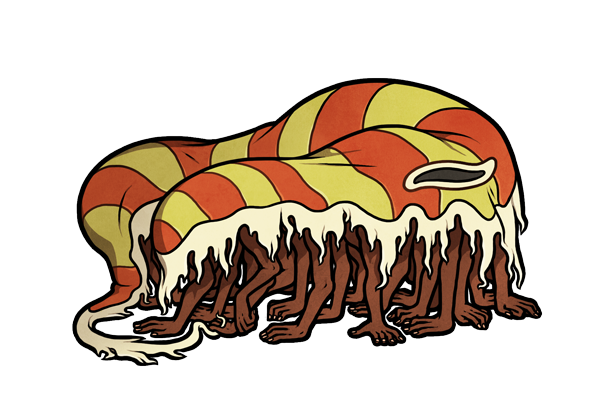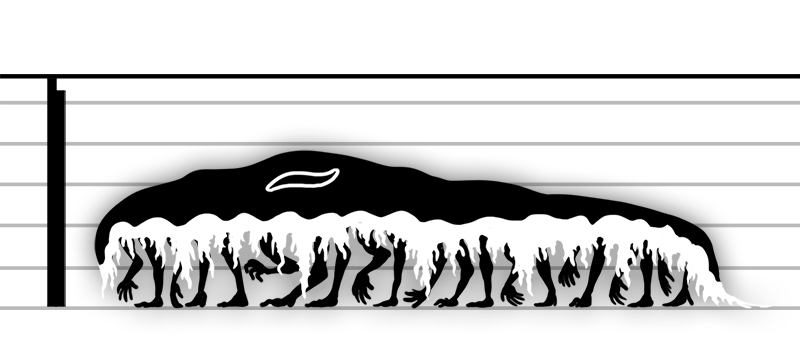

Tantani
the Cascades
prefix tan suffix tani
physical appearance
The tantani /tæn'tæni/ is an orange and yellow stranger with either twenty-five, twenty-seven, or twenty-nine arms, these arms emerging from beneath its tarp-like skin. Though lacking bones, the structured and rigid "human" arms support and carry the tantani with confidence. The "skin" color on each of the tantani's arms corresponds to the mean human complexion of the region; conditions such as vitiligo, eczema, or blotchman's thus appear as expected.
The tantani's arms regenerate quickly when injured, and with little bleeding. Furthermore, the stranger is able to reject a badly wounded arm, the limb softening at the base and detaching; severed arms always regrow. The tarp, meanwhile, proves durable against most manners of fire, cuts, and rip-shreds, though its endurance cannot fully compensate for natural wear and tear. A tantani's age can be inferred from the fraying of its cape-edges, though such degradation does not affect its vibrancy, nor its stability.
The tantani refrains from vocalization.
its palms pat the bare earth below.

environment and generation
This strain finds its necessary conditions in wooded non-parks, and appears near highways, in the suburbs, or at the outskirts of the developing urban sprawl. Proving fortuitous to its generation are tunnels, pine trees, unadorned cement barricades, rows of yellow humming lights, and dirt spread over cement. Each spawning point remains "active" for some time, producing upwards of forty tantani before losing its viability.
Within these auspicious zones, the tantani flutters into view in an infantile form. It first pulls itself with one hand, growing more co-ordinated as its size inflates stumble-by-skip and new arms reach downward to balance the skin's increasing weight. The developing tantani wastes no time in beginning its wander beneath rain-cover bridges and under shade of sycamore within these last few "wilds".
behaviour
The deft (if unrefined) tantani is characterized by a nomadic lifestyle and a restless complacency. Though tending towards treed spaces in its brisk roam, it is not averse to exploration. It chooses to travel on or along pre-existing paths (such as roads, above-ground pipelines, and fences) whenever possible, and forms neither routines, nor territories.
As it courses through the city, its attention becomes drawn by human objects,𐆙 which it grabs with one of its forelimbs, manipulates,Ꮸ and then passes down the line. The stranger displays a distinct "handedness" in both the object it uses to grab the object, and in its subsequent handling of the item it examines (and ultimately rejects, with a dissatisfied fling). A minimum (21.9%) of tantani are right-handed, with the remainder displaying a left-hand dominance.
𐆙 Its tastes cannot be predicted. The odd bit of cloth here and there, a dead phone on a windowsill, a knotted cable, a chicken bone, a knife with a beheaded vile king etched on the side.
Ꮸ Its actions equally "odd". It pinches a frying pan and strokes a yellow plastic bag. It does not try to open a book. It pounds its fist against an empty cigarette box. It pretends to read the poem.
A left-handed tantani is subtly emotive (embarrassed, awkward in its actions), and fidgets as it passes objects palm-to-palm. It scrapes its fingernails upon cinderblocks and human-cut boulder-rocks to cut them short, and in mud, its hand-prints fill up with blood.
A right-handed tantani, meanwhile, passes objects smoothly down its hands. Items, furthermore, circulate between hands for twice as long. In demeanor, it is rigid and constrained, when not coy. On white marble, it leaves behind bloody prints, and it uses human implements (scissors, et cetera) to cut its nails.
The rare "ambidextrous" tantani (appearing at a 0.0313332% rate) does not last long. Their maturation brings about contradiction, and as the divergent behaviours overlap,ṯ so too does the tantani's stability drop,Ⴍ leading its short life to a quick death.
ṯ It grows frantic as it circulates held objects for hours, trails blood and cuts its fingertips with bladed edges, rigid and explosive in its responses.
Ⴍ Overlapping errors, repeating errors.
interactions between tantani
It is inevitable that, during the tantani's travels, it will come across another of its strain. The subsequent interactions vary depending on polarity. A right handed stranger is gregarious, while those left-handed tend to be the more aggressive. Though territories are not maintained, perimeters are quickly established, with the left-handed tantani pushing the more docile from their path, and brusquely dismissing any further exchange.
Strains of the same handedness, however, are generally distanced, if somewhat less so in those right-handed.
The dead and dying ambidextrous stragglers are, expectedly, avoided.
interactions with other strains
All tantani attempt to touch the various other strains that their paths cross.Ꮳ Despite this intrusion of personal space, even the vast majority of predatory strains do not harm or hunt a tantani. When able, they regard the wandering stranger with a distanced annoyance, if any reaction at all.
Ꮳ Tapping at the endroni's sides, or trying to reach its hands. Tugging at the drosodroni a few times, before it gives up.
this time, it's coming to you
do you want to go all the way?
and you won't have to come down.

Ϟ
Ⅎ
Ⅎ
interactions with sensitives
A reclusive stranger, the tantani does not readily allow itself to be observed by a sensitive, and does not stop for one. The stranger is best encountered if confined to a large, but enclosed space. Given no way to continue its roam, the tantani grows quizzical, then patiently uneasy.
The stranger does not cease waiting for an exit path, but does not move if one does not present. It will not approach the sensitive, but does not appear explicitly frightened.
It grows active and seeks a more immediate escape only when attacked. Physical force is left as a last resort, and only when the tantani is cornered. In defending itself, the normally apprehensive stranger uses its many arms to pin down and immobilize the sensitive. Its hands alone have more than enough strength to break limbs, which the stranger will not hesitate to do in order to ensure its own safety. It sometimes inflicts up to three fractures to the same bone, should the sensitive present themselves as an overt threat.⺇
⺇ An assumption which leads to the deaths of many a novice hunter, who might mistake the tantani's unassuming demeanor as helplessness.
Physical contact with the tantani causes no physical harm to either the stranger or the sensitive. It does, however, change the appearance of the tantani's arms. For a tantani touched by one sensitive, the arms show a random half-and-half split; the arms of a tantani touched by five sensitives, meanwhile, shows five distinct arm "colors" in equal ratio. (Laterality of the arms depends furthermore upon the sensitive's own handedness.)
The tantani is not without its influence upon the sensitive, however. As the tantani becomes muddled with the outward form of its "all-too-human arch-enemy", so too, it tugs upon the handedness of the sensitive. After a sharp twitch and a dragging pain, the dominant hand reverses. After a diminished atrophic phase, there are no impediments to fluent motor skills in the new dominant hand.
Ambidextrous sensitives, meanwhile are soured ambisinistrous by their touch upon the stranger. Neither does the tantani come out unscathed, developing its own fatal ambidexterity. Following its expected "madness", the stranger dies twitching, poly-handed, and sharply crumpled.
aging and death
A tantani grows neither wrinkled nor excessively tattered with age; rather, it dies from the arms up. The limbs grow limp one-by-one in the final few hours of its life. The non-dominant side shows greater die-off at first, though the increasingly nervous stranger more-or-less balances itself until its final staggers into bush-cover, bag-pile, or whatever "shelter" can be found in its last dozen steps before its undignified end.
A tantani's corpse becomes putrescent, even the once tarp-like skin turning slimy and foul. It rots quickly - within one hour, the "arms" no longer appear humanoid at all. The pile (drape and all) turn to mush by the end of a week.



